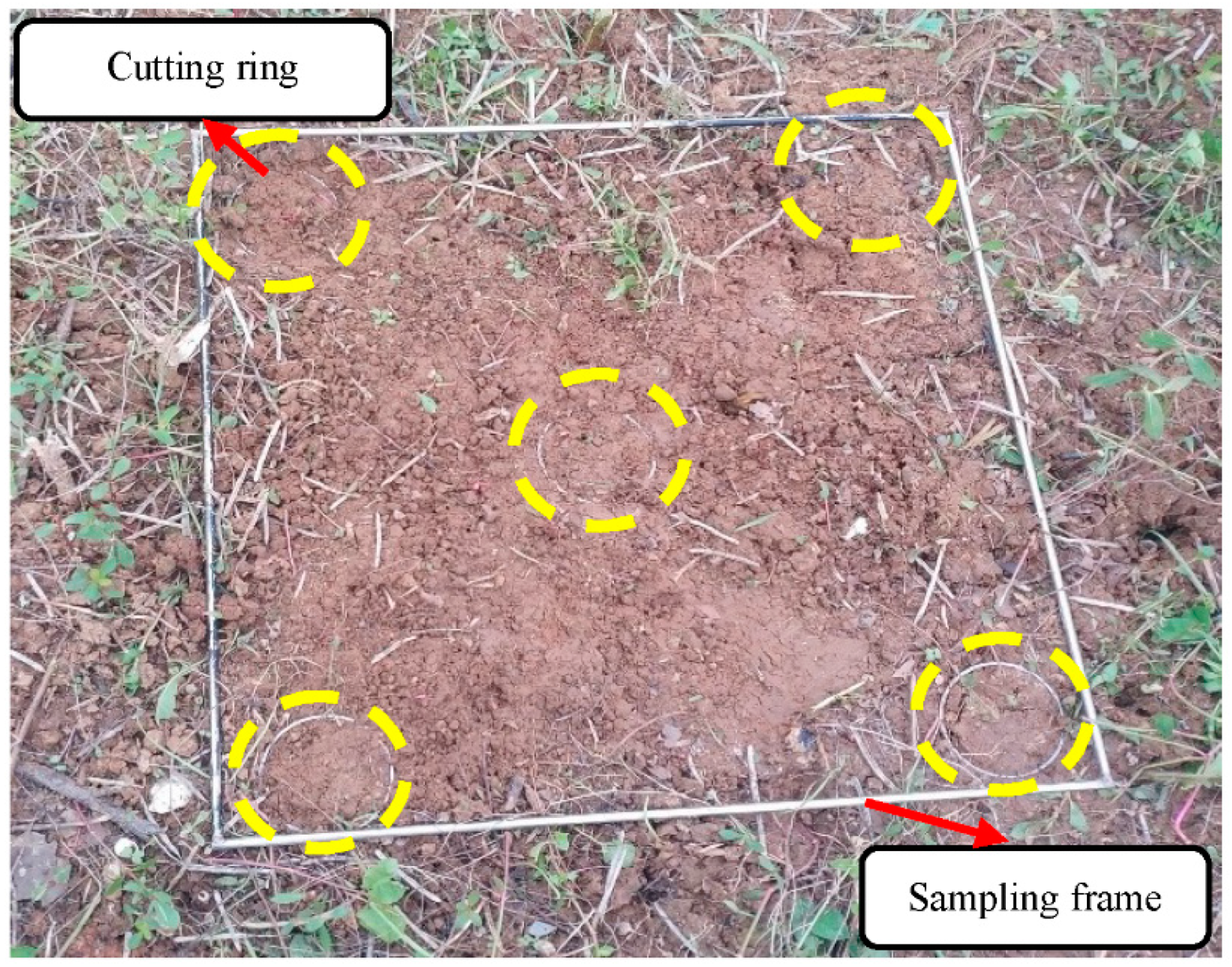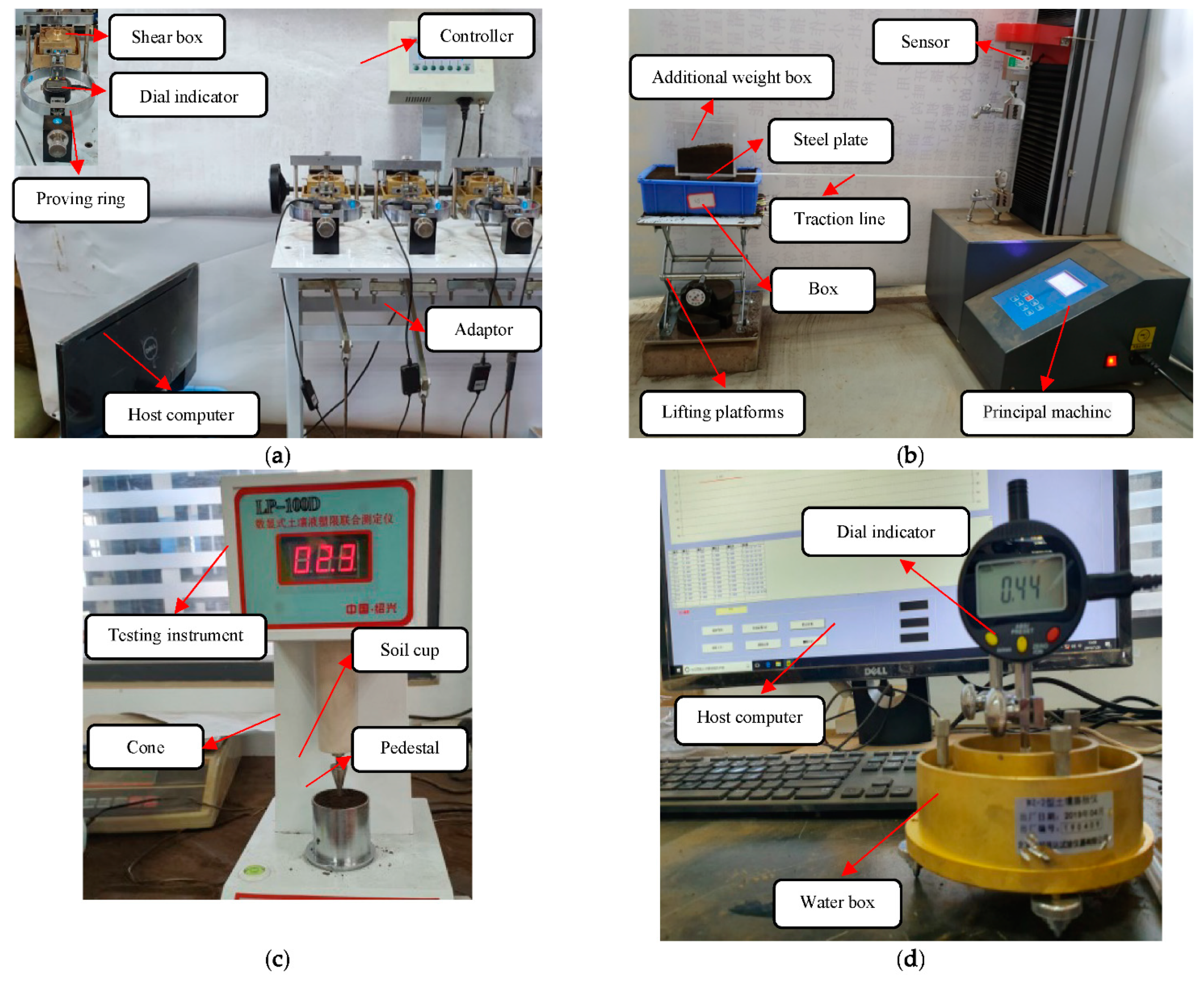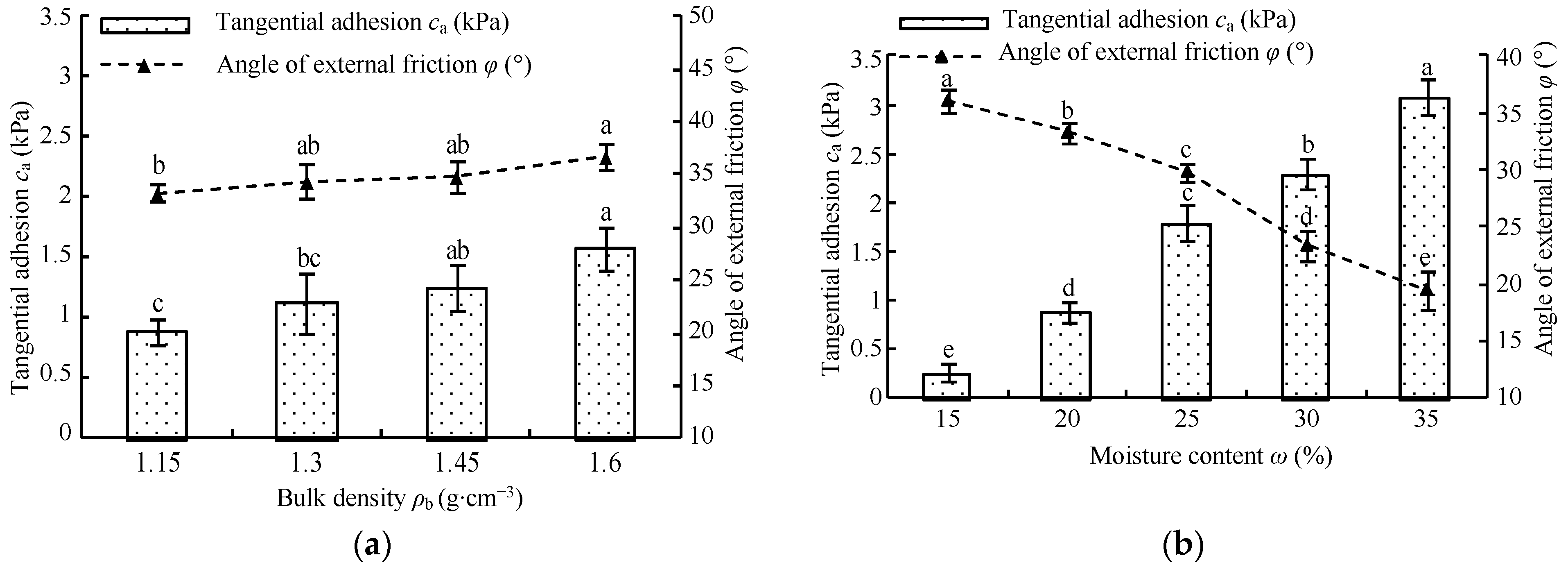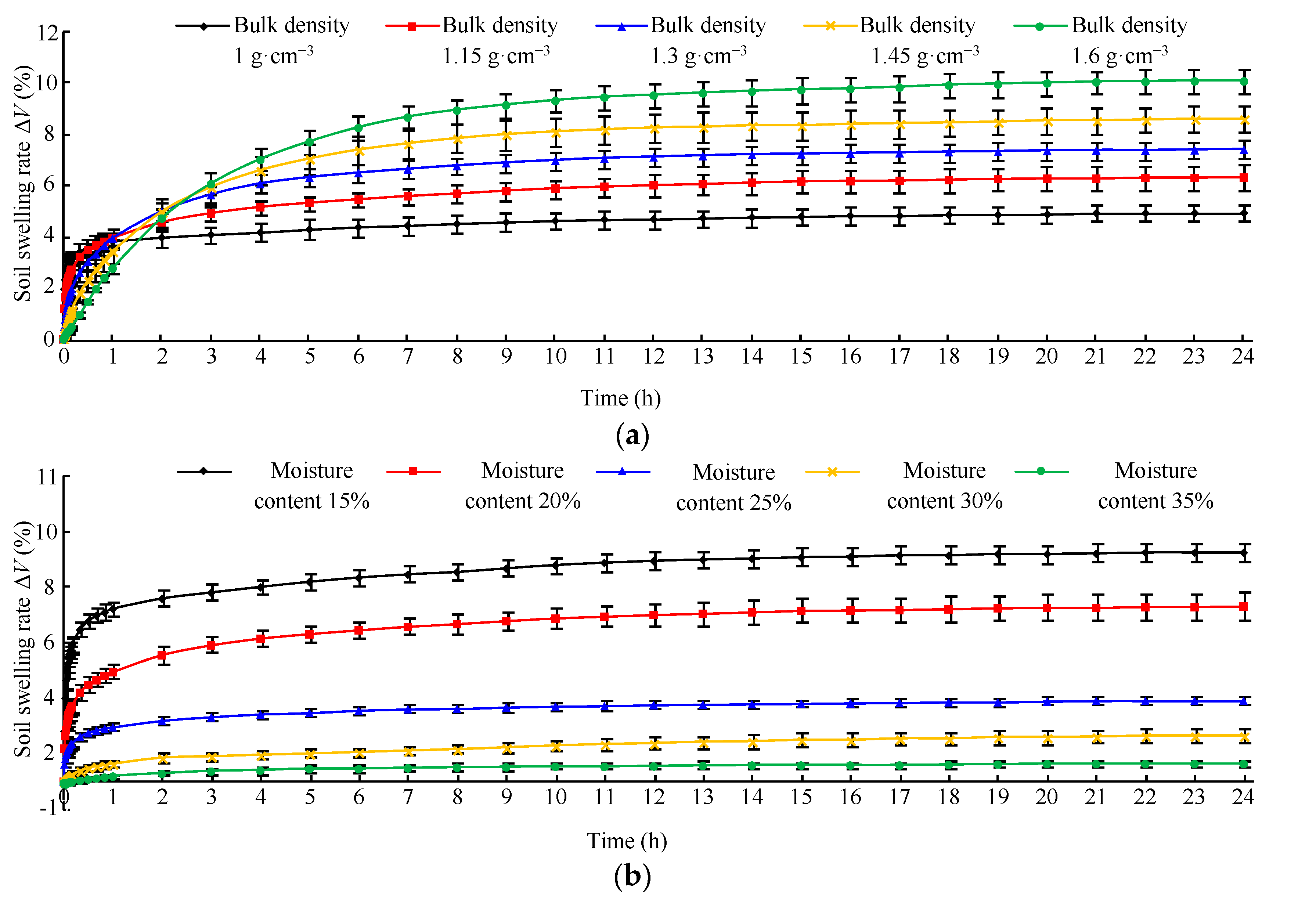Effects of Soil Bulk Density and Moisture Content on the Physico-Mechanical Properties of Paddy Soil in Plough Layer
Abstract
:1. Introduction
2. Materials and Methods
2.1. Materials
2.2. Experimental Design
2.2.1. Determination of Experimental Factors
2.2.2. Preparation of Experimental Specimens
2.3. Methods
2.3.1. Cohesion
2.3.2. Adhesion
2.3.3. Plasticity Index
2.3.4. Swelling Rate
3. Results
3.1. Changes in the Cohesion of Paddy Soil
3.2. Changes in the Tangential Adhesion of Paddy Soil
3.3. Changes in the Plastic Index of Paddy Soil
3.4. Changes in the Swelling Rate of Paddy Soil
4. Discussion
4.1. Analysis of the Reasons for the Effect of Bulk Density on the Physico-Mechanical Properties of Paddy Soil in the Plough Layer
4.2. Analysis of the Reasons for the Effect of Moisture Content on the Physico-Mechanical Properties of Paddy Soil in the Plough Layer
5. Conclusions
Author Contributions
Funding
Institutional Review Board Statement
Informed Consent Statement
Data Availability Statement
Conflicts of Interest
References
- Jun-Zheng, P.; Zhi-Xiong, L. Prediction of paddy soil normal adhesion to steel surfaces by fuzzy logic. J. Terramechanics 1998, 35, 103–107. [Google Scholar] [CrossRef]
- Tiwari, B.; Ajmera, B. A new correlation relating the shear strength of reconstituted soil to the proportions of clay minerals and plasticity characteristics. Appl. Clay Sci. 2011, 53, 48–57. [Google Scholar] [CrossRef]
- Mouazen, A.M.; Ramon, H.; de Baerdemaeker, J. SW—Soil and water. Biosyst. Eng. 2002, 83, 217–224. [Google Scholar] [CrossRef]
- Liu, X.; Liu, E.; Zhang, D.; Zhang, G.; Yin, X.; Song, B. Study on effect of coarse-grained content on the mechanical properties of frozen mixed soils. Cold Reg. Sci. Technol. 2019, 158, 237–251. [Google Scholar] [CrossRef]
- Smith, C.; Johnston, M.; Lorentz, S. The effect of soil compaction and soil physical properties on the mechanical resistance of South African forestry soils. Geoderma 1997, 78, 93–111. [Google Scholar] [CrossRef]
- Rezaee, L.; Moosavi, A.A.; Davatgar, N.; Sepaskhah, A.R. Shrinkage-swelling characteristics and plasticity indices of paddy soils: Spatial variability and their influential parameters. Arch. Agron. Soil Sci. 2020, 66, 2005–2025. [Google Scholar] [CrossRef]
- Chen, Z.; Li, P.; Jiang, S.; Chen, H.; Wang, J.; Cao, C. Evaluation of resource and energy utilization, environmental and economic benefits of rice water-saving irrigation technologies in a rice-wheat rotation system. Sci. Total Environ. 2021, 757, 143748. [Google Scholar] [CrossRef] [PubMed]
- Zhu, D.; Zhang, J.; Lu, J.; Cong, R.; Ren, T.; Li, X. Optimal potassium management strategy to enhance crop yield and soil potassium fertility under paddy-upland rotation. J. Sci. Food Agric. 2021, 101, 3404–3412. [Google Scholar] [CrossRef] [PubMed]
- Fang, Y.; Ren, T.; Zhang, S.; Liu, Y.; Liao, S.; Li, X.; Cong, R.; Lu, J. Rotation with oilseed rape as the winter crop enhances rice yield and improves soil indigenous nutrient supply. Soil Tillage Res. 2021, 212, 105065. [Google Scholar] [CrossRef]
- Zhou, H.; Fang, H.; Mooney, S.; Peng, X. Effects of long-term inorganic and organic fertilizations on the soil micro and macro structures of rice paddies. Geoderma 2016, 266, 66–74. [Google Scholar] [CrossRef] [Green Version]
- Yang, Z.-P.; Xu, M.-G.; Zheng, S.-X.; Nie, J.; Gao, J.-S.; Liao, Y.-L.; Xie, J. Effects of long-term winter planted green manure on physical properties of reddish paddy soil under a double-rice cropping system. J. Integr. Agric. 2012, 11, 655–664. [Google Scholar] [CrossRef]
- Zhang, Z.; Peng, X.; Wang, L.; Zhao, Q.; Lin, H. Temporal changes in shrinkage behavior of two paddy soils under alternative flooding and drying cycles and its consequence on percolation. Geoderma 2013, 192, 12–20. [Google Scholar] [CrossRef]
- Tang, H.; Xiao, X.; Li, C.; Tang, W.; Cheng, K.; Pan, X.; Wang, K.; Li, W. Effects of different soil tillage systems on soil carbon management index under double-cropping rice field in southern China. Agron. J. 2019, 111, 440–447. [Google Scholar] [CrossRef]
- Huang, M.; Zou, Y.; Jiang, P.; Xia, B.; Feng, Y.; Cheng, Z.; Mo, Y. Effect of tillage on soil and crop properties of wet-seeded flooded rice. Field Crop. Res. 2012, 129, 28–38. [Google Scholar] [CrossRef]
- Zhang, C.; Li, X.; Yan, H.; Ullah, I.; Zuo, Z.; Li, L.; Yu, J. Effects of irrigation quantity and biochar on soil physical properties, growth characteristics, yield and quality of greenhouse tomato. Agric. Water Manag. 2020, 241, 106263. [Google Scholar] [CrossRef]
- Bartzanas, T.; Bochtis, D.; Sørensen, C.; Sapounas, A.; Green, O. A numerical modelling approach for biomass field drying. Biosyst. Eng. 2010, 106, 458–469. [Google Scholar] [CrossRef]
- Jiang, Q.; Cao, M.; Wang, Y.; Wang, J.; He, Z. Quantification of the soil stiffness constants using physical properties of paddy soils in Yangtze Delta Plain, China. Biosyst. Eng. 2020, 200, 89–100. [Google Scholar] [CrossRef]
- Zhang, G. Chinese Soil Series, 1st ed.; Science Press: Beijing, China, 2017. [Google Scholar]
- Soil and Fertilizer Station of Hubei Province. Soil Survey Office of Hubei Province. Hubei Provincial Soil Species Journal; Hubei Science and Technology Press: Wuhan, China, 2015; pp. 329–569.
- Ucgul, M.; Fielke, J.; Saunders, C. Three-dimensional discrete element modelling (DEM) of tillage: Accounting for soil cohesion and adhesion. Biosyst. Eng. 2015, 129, 298–306. [Google Scholar] [CrossRef]
- Barzegar, M.; Hashemi, S.; Nazokdast, H.; Karimi, R. Evaluating the draft force and soil-tool adhesion of a UHMW-PE coated furrower. Soil Tillage Res. 2016, 163, 160–167. [Google Scholar] [CrossRef]
- Arthur, E.; Rehman, H.U.; Tuller, M.; Pouladi, N.; Nørgaard, T.; Moldrup, P.; de Jonge, L.W. Estimating Atterberg limits of soils from hygroscopic water content. Geoderma 2021, 381, 114698. [Google Scholar] [CrossRef]
- Yao, H.; She, J.; Lu, Z.; Luo, X.; Xian, S.; Fang, R.; Chen, Z. Inhibition effect of swelling characteristics of expansive soil using cohesive non-swelling soil layer under unidirectional seepage. J. Rock Mech. Geotech. Eng. 2019, 12, 188–196. [Google Scholar] [CrossRef]
- Zhang, S.; Leng, X.; Sheng, Q.; Li, B.; Zhou, Y. Swelling and shrinkage characteristics study of Lushi expansive rock under dry and wet circulation. Rock Soil Mech. 2019, 40, 1–11. [Google Scholar] [CrossRef]
- Mouazen, A.M.; Ramon, H. A numerical-statistical hybrid modelling scheme for evaluation of draught requirements of a subsoiler cutting a sandy loam soil, as affected by moisture content, bulk density and depth. Soil Tillage Res. 2002, 63, 155–165. [Google Scholar] [CrossRef]
- Håkansson, I.; Lipiec, J. A review of the usefulness of relative bulk density values in studies of soil structure and compaction. Soil Tillage Res. 2000, 53, 71–85. [Google Scholar] [CrossRef]
- Pires, L.; Cássaro, F.; Bacchi, O.; Reichardt, K. Non-destructive image analysis of soil surface porosity and bulk density dynamics. Radiat. Phys. Chem. 2011, 80, 561–566. [Google Scholar] [CrossRef] [Green Version]
- Villar, M.V.; Lloret, A. Influence of dry density and water content on the swelling of a compacted bentonite. Appl. Clay Sci. 2008, 39, 38–49. [Google Scholar] [CrossRef]
- Luckham, P.F.; Rossi, S. The colloidal and rheological properties of bentonite suspensions. Adv. Colloid Interface Sci. 1999, 82, 43–92. [Google Scholar] [CrossRef] [Green Version]
- Havaee, S.; Mosaddeghi, M.; Ayoubi, S. In situ surface shear strength as affected by soil characteristics and land use in calcareous soils of central Iran. Geoderma 2015, 237-238, 137–148. [Google Scholar] [CrossRef]
- Zhang, B.; Zhao, Q.; Horn, R.; Baumgartl, T. Shear strength of surface soil as affected by soil bulk density and soil water content. Soil Tillage Res. 2001, 59, 97–106. [Google Scholar] [CrossRef]
- Wei, J.; Shi, B.; Li, J.; Li, S.; He, X. Shear strength of purple soil bunds under different soil water contents and dry densities: A case study in the Three Gorges Reservoir Area, China. Catena 2018, 166, 124–133. [Google Scholar] [CrossRef]
- Al-Shayea, N.A. The combined effect of clay and moisture content on the behavior of remolded unsaturated soils. Eng. Geol. 2001, 62, 319–342. [Google Scholar] [CrossRef]
- Zhang, J.; Wang, X.; Kito, K.; Sato, K. Characteristics of tangential soil adhesion to tool material at different moisture contents. Int. Agric. Eng. J. 2013, 22, 65–71. Available online: https://www.cabdirect.org/cabdirect/abstract/20133361164 (accessed on 19 August 2021).
- Neal, M.S. Friction and adhesion between soil and rubber. J. Agric. Eng. Res. 1966, 11, 108–112. [Google Scholar] [CrossRef]
- Jia, X. Theoretical analysis of the adhesion force of soil to solid materials. Biosyst. Eng. 2004, 87, 489–493. [Google Scholar] [CrossRef]
- Wang, Q.; Cui, Y.-J.; Tang, A.M.; Xiang-Ling, L.; Wei-Min, Y. Time- and density-dependent microstructure features of compacted bentonite. Soils Found. 2014, 54, 657–666. [Google Scholar] [CrossRef] [Green Version]
- Zhang, T.; Deng, Y.; Cui, Y.; Lan, H.; Zhang, F.; Zhang, H. Porewater salinity effect on flocculation and desiccation cracking behaviour of kaolin and bentonite considering working condition. Eng. Geol. 2019, 251, 11–23. [Google Scholar] [CrossRef]






| Texture | Bulk Density (g∙cm−3) (N1 = 10) | Moisture Content (%) (N1 = 10) | Particle Composition (%) | ||||
|---|---|---|---|---|---|---|---|
| Average Value | Standard Deviation | Average Value | Standard Deviation | Clay <0.002 mm | Silt 0.05~2.0 mm | Sand 0.05~2.0 mm | |
| Silty clay | 1.15 | 0.15 | 20.03 | 1.24 | 42.46 | 49.29 | 8.05 |
| Province/City | Bulk Density (g∙cm−3) | Measured Depth (cm) | |
|---|---|---|---|
| Average Value | Range | ||
| Shanghai (N2 = 35) | 1.17 | [0.95, 1.37] | 15.80 |
| Jiangsu (N2 = 89) | 1.18 | [0.82, 1.58] | 15.15 |
| Zhejiang (N2 = 46) | 1.10 | [0.92, 1.34] | 15.69 |
| Jiangxi (N2 = 43) | 1.17 | [1.04, 1.61] | 15.03 |
| Anhui (N2 = 66) | 1.18 | [1.02, 1.43] | 15.38 |
| Hubei (N2 = 91) | 1.20 | [0.95, 1.60] | 15.32 |
| Hunan (N2 = 96) | 1.16 | [0.96, 1.62] | 15.14 |
| Levels | Experimental Factors | |
|---|---|---|
| Bulk Density ρb (g∙cm−3) | Moisture Content ω (%) | |
| 1 | 1 | 15 |
| 2 | 1.15 | 20 |
| 3 | 1.3 | 25 |
| 4 | 1.45 | 30 |
| 5 | 1.6 | 35 |
| Factors and Levels | Plastic Limit PL (%) | Liquid Limit LL (%) | Plasticity Index IP (%) | Fitting Curve | R2 | |
|---|---|---|---|---|---|---|
| C | d | |||||
| Bulk density 1 g·cm−3 | 19.313 | 35.842 | 16.529 | 0.0009 | 2.6028 | 0.9977 |
| Bulk density 1.15 g·cm−3 | 19.787 | 37.530 | 17.743 | 0.0011 | 2.5144 | 0.9965 |
| Bulk density 1.3 g·cm−3 | 20.777 | 40.415 | 19.638 | 0.0013 | 2.4189 | 0.9995 |
| Bulk density 1.45 g·cm−3 | 21.388 | 42.157 | 20.769 | 0.0014 | 2.3718 | 0.9959 |
| Bulk density 1.6 g·cm−3 | 22.171 | 44.619 | 22.448 | 0.0016 | 2.3012 | 0.9975 |
Publisher’s Note: MDPI stays neutral with regard to jurisdictional claims in published maps and institutional affiliations. |
© 2021 by the authors. Licensee MDPI, Basel, Switzerland. This article is an open access article distributed under the terms and conditions of the Creative Commons Attribution (CC BY) license (https://creativecommons.org/licenses/by/4.0/).
Share and Cite
Zheng, K.; Cheng, J.; Xia, J.; Liu, G.; Xu, L. Effects of Soil Bulk Density and Moisture Content on the Physico-Mechanical Properties of Paddy Soil in Plough Layer. Water 2021, 13, 2290. https://doi.org/10.3390/w13162290
Zheng K, Cheng J, Xia J, Liu G, Xu L. Effects of Soil Bulk Density and Moisture Content on the Physico-Mechanical Properties of Paddy Soil in Plough Layer. Water. 2021; 13(16):2290. https://doi.org/10.3390/w13162290
Chicago/Turabian StyleZheng, Kan, Jian Cheng, Junfang Xia, Guoyang Liu, and Lei Xu. 2021. "Effects of Soil Bulk Density and Moisture Content on the Physico-Mechanical Properties of Paddy Soil in Plough Layer" Water 13, no. 16: 2290. https://doi.org/10.3390/w13162290
APA StyleZheng, K., Cheng, J., Xia, J., Liu, G., & Xu, L. (2021). Effects of Soil Bulk Density and Moisture Content on the Physico-Mechanical Properties of Paddy Soil in Plough Layer. Water, 13(16), 2290. https://doi.org/10.3390/w13162290





